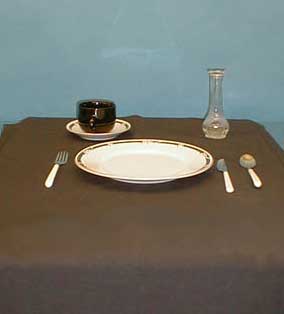Demos: 1F-07 Table Cloth Jerk

A set of dinner dishes is placed on a “table cloth” and the cloth is jerked rapidly out from under the dishes with very little disturbance. The small amount of friction between the cloth and the dishes generates a force that acts only during the time the cloth is in contact, less than second. This is insufficient time to produce any significant movement of the relatively massive objects on the cloth.
Directions: Place the cloth on the table (a small smooth finished table resting on the lecture desk) and carefully position the plate, glass and silverware. (This will likely have been done by the lecture demo technician ahead of time.) Leave just enough cloth to hang slightly over the opposite end. Bunch the cloth in your hand in such a way as to avoid wrinkles on the table portion. Move your hand forward and then give a rapid jerk backward (do it quickly!). The cloth will come free and the dishes will be hardly disturbed.
Suggestions for Presentation: This demo should be done with flair. You probably won’t have to pretend being nervous about doing it. There is the feeling always that maybe one day it won’t work! But it always does, if done properly. After doing the demo, point out that there is a force acting on the dishes, but it lasts for a very short time. Combined with the relatively large mass (compared with the cloth) of the dishes, this force is over so quickly and is so small that the dishes hardly move. The role of the mass of the dishes can be illustrated by trying (or talking about) this same demonstration with paper plates, paper cups and plastic flatware!
Applications: Compare this demo with the others in the series: 1F-01, 1F-02, 1F-05, 1F-06
Last Updated: Nov 30, 2023 11:25 AM